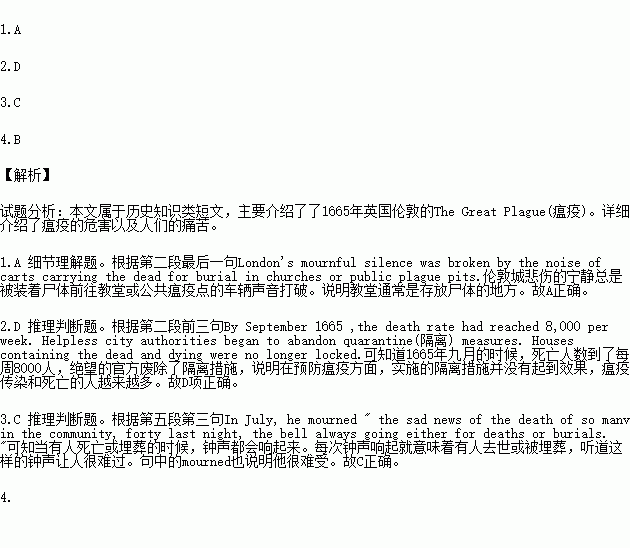题目内容
The Great Plague(瘟疫) of London in 1665 was the last in a long senies of plague that first began in London in June 1499.1t killed between 75,000 and 100,000. First suspected in late 1664,it began to spread eastwards in April 1665 from the poor suburb of St. Giles to the crowded and dirty communities on its way to the walled City of London.
The Great Plague at Its Peak
By September 1665 ,the death rate had reached 8,000 per week. Helpless city authorities began to abandon quarantine(隔离) measures. Houses containing the dead and dying were no longer locked. London's mournful silence was broken by the noise of carts carrying the dead for burial in churches or public plague pits.
Well-off residents soon fled to the countryside, leaving the poor behind in poor old commun/ties. Thousands of dogs and cats were killed to remove a feared source of contagion (传染) ,and piles of rotting garbage were burned. Doctors cut swellings and bled black spots in attempts to cure plague victims.
Plague Orders prohibited churches from keeping dead bodies in their buildings during public assemblies or services, and camers of the dead had to identify themselves and could not mix with the public.
Samuel Pepys: Eyewitness Accounts
In his famous diary, Samuel Pepys, a member of Parliament, conveyed the sad image of desperate people wandering the streets in search of relief from the ruins of the plague. His notes during 1665 indicated the severity of London's Great Plague. In July, he mourned " the sad news of the death of so manv in the community, forty last night, the bell always going either for deaths or burials. " A month later, when London's death rate rose sharply, Pepys noted that surviors are forced to carry the dead to be buried by daylight, the nights not enough to do it
The Plague Declines and the Government Reacts
By February 1666,the Great Plague had nearly run its course.lt died out during the Great Fire that same year and never returned. Central parts of London were rebuilt with wider streets to relieve crowding and better waste water svstems to improve public cleanliness. New Plague Orders were issued in May 1666,which banned the burial of future plague victims in churches and small churchyards, enforced the use of quicklime (生石灰) at chosen burial sites, and strictly prohibited opening graves less than one year after burial as a safeguard against the spread of infection.
1.1n the course of the Great PJague,it was a common practice to .
A. keep dead bodies in the church buildings
B. burn piles of rotting garbage in the streets
C. carry the dead for church burials in the daytime
D. unlock the houses containing the dead and dying
2.lt can be inferred from the passage that .
A. dogs and cats were certain to spread the piague
B. doctors' treatment of plague victims was effective
C. city authorities allowed rich residents to go to the countryside
D. quarantine measures were powerless in preventing the plague
3.How did Samuel Pepys feel when the bell was going all the night during the Great Plague?
A. Frightened. B. Relieved.
C. Sorrowful. D. Moody.
4.What's the main purpose of this writing?
A. To blame poor public cleanliness for plague.
B. To inform readers of what happened in the Great Plague.
C. To show that plague was closely related to church activities.
D. To prove that plague could be controlled by humans.
 启东小题作业本系列答案
启东小题作业本系列答案书面表达
高考在即,高三学生目前正处在紧张复习迎考的氛围中。假如你叫李华,是某中学高三学生,面对目前的压力,想和父母说些知心话,请你用英文在你的博客上用书信形式表达出来。主要内容如下:
知心话 | |
感恩 | 关切鼓励,倾注爱心 |
对父母 的期望 | 多交流,使自己保持良好的状态 创造条件,给自己提供适时帮助 |
学习打算 | 考生自拟(至少写三点) |
注意:1.短文需包括所有内容要点,可适当发挥;
2.词数:100左右。开头已给出,不计入总词数。
Dear Mom and Dad,
The annual college entrance examination is around the corner. On this special occasion, how I wish I could have a heart to heart talk with you.

